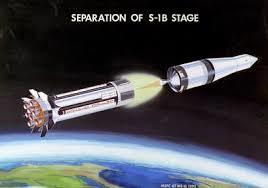Astronaut's Momentum
A two-stage rocket moves in space at a constant velocity of 4900 m/s. The two stages are then separated by a small explosive charge placed between them. Immediately after the explosion the velocity of the 1200 kg upper stage is 5700 m/s in the same direction as before the lower explosion. What is the velocity (in m/s) of the 2400 kg lower stage after the explosion?

The answer is 4500.
This section requires Javascript.
You are seeing this because something didn't load right. We suggest you, (a) try
refreshing the page, (b) enabling javascript if it is disabled on your browser and,
finally, (c)
loading the
non-javascript version of this page
. We're sorry about the hassle.

Let the masses of the upper stage and lower stage be m 1 and m 2 , their initial velocity together before the explosion be v 0 and their velocities after the explosion be v 1 and v 2 respectively. Then by conservation of momentum, we have:
( m 1 + m 2 ) v 0 ⟹ v 2 = m 1 v 1 + m 2 v 2 = m 2 ( m 1 + m 2 ) v 0 − m 1 v 1 = 2 4 0 0 ( 1 2 0 0 + 2 4 0 0 ) 4 9 0 0 − 1 2 0 0 ( 5 7 0 0 ) = 4 5 0 0 m/s